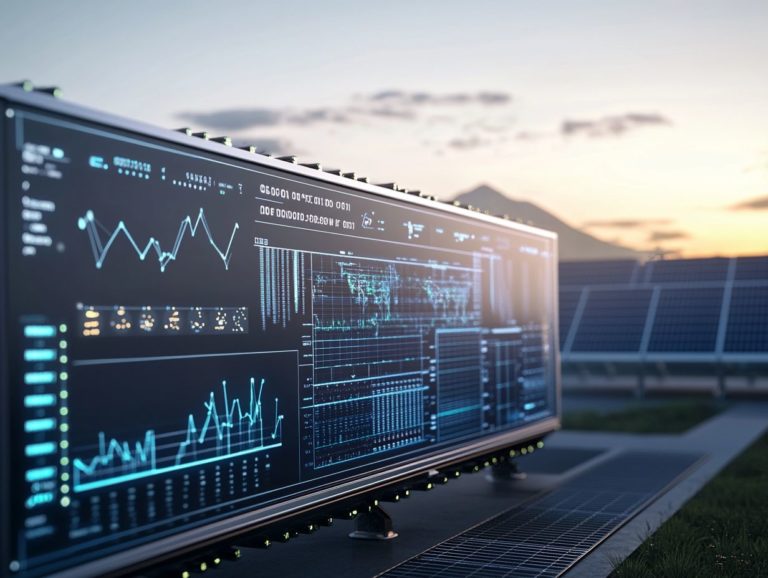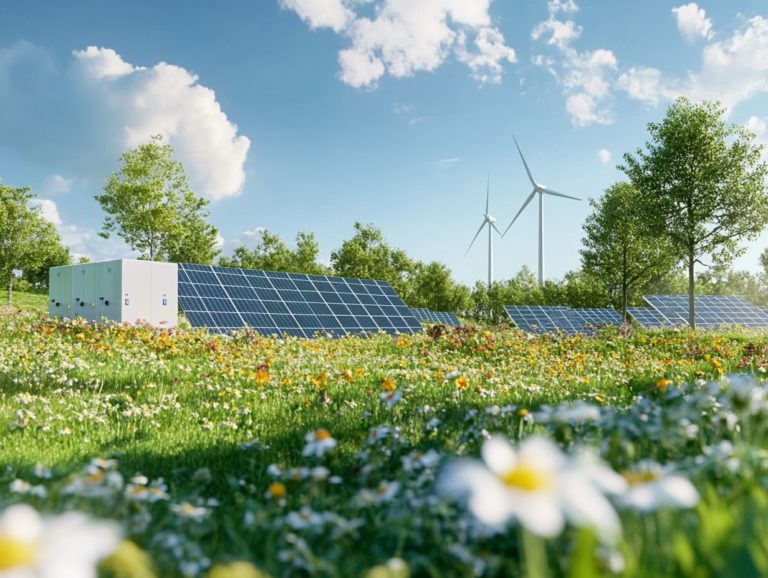Understanding the Costs Involved in Energy Storage
Energy storage technologies stand as a pivotal element in shaping your energy future. They allow you to efficiently harness renewable resources while maintaining a steady power supply.
This article explores various energy storage systems available today. These include battery technologies like lithium-ion, vanadium flow, and hydrogen bromine flow batteries, as well as pumped hydro and thermal storage.
It highlights the advantages of integrating these systems, such as lowering energy expenses and boosting reliability.
By considering key factors, you can select the ideal energy storage solution tailored to your unique needs.
Contents
- Key Takeaways:
- Types of Energy Storage Systems
- Factors Affecting Energy Storage Costs
- Benefits of Energy Storage
- Considerations for Choosing an Energy Storage System
- Frequently Asked Questions
- What is energy storage and why is it important to understand its costs?
- What Costs Should You Expect for Energy Storage?
- How Do Costs Vary Among Different Energy Storage Technologies?
- What Key Factors Influence the Costs of Energy Storage?
- How Can Understanding Energy Storage Costs Aid Project Planning?
- Are There Potential Cost Savings with Energy Storage?
Key Takeaways:
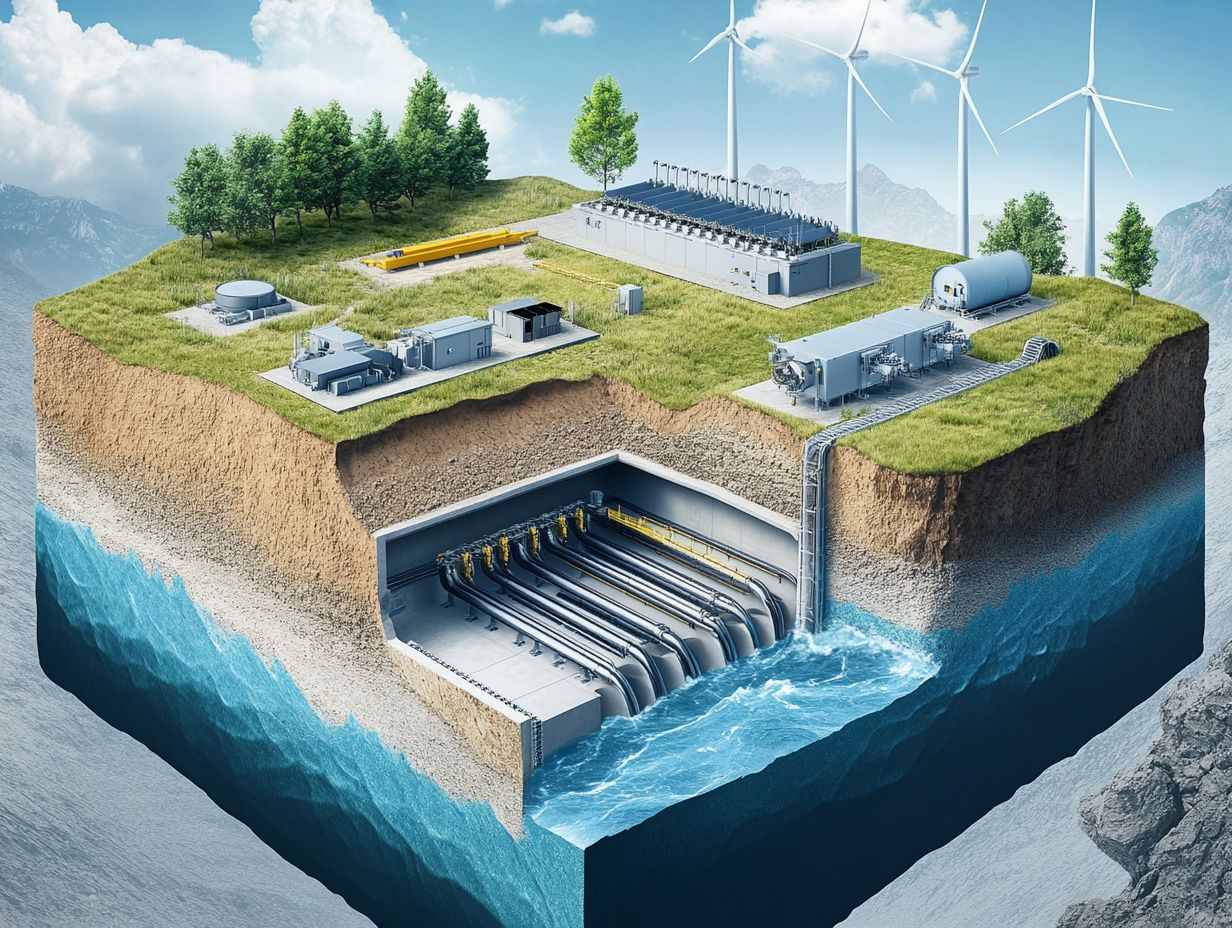
- Energy storage systems vary in cost based on technology, materials, installation, and maintenance.
- Investing in energy storage can reduce energy costs and increase reliability and flexibility.
- Conduct a thorough cost vs. benefits analysis when considering an energy storage system to ensure long-term sustainability.
What is Energy Storage?
Energy storage encompasses technologies and systems designed to capture and store energy for future use. This is crucial as we transition towards renewable sources.
Battery storage enhances grid reliability and supports the integration of solar PV and other renewable systems.
By giving power to energy management systems, you can optimize usage and minimize costs. Energy storage is essential for achieving energy independence.
This technology plays a vital role in balancing supply and demand, especially with fluctuating energy sources. Advanced battery technologies, like lithium-ion and flow batteries, provide dynamic energy management.
Energy storage systems help reduce operational costs and improve resilience, supporting the move towards a more sustainable and reliable energy future.
Types of Energy Storage Systems
Energy storage systems come in various types, each designed for specific energy demands. Battery technologies, such as lithium-ion, vanadium flow, and hydrogen bromine flow batteries, are versatile solutions for both commercial and residential applications.
Pumped hydro storage and thermal storage are essential systems that improve grid stability and enhance energy efficiency.
Battery Storage
Battery storage technologies, including lithium-ion, vanadium flow, and hydrogen bromine flow batteries, offer efficient solutions for capturing and releasing energy. These technologies are critical in modern energy systems.
You can find these batteries being utilized in various applications, from residential energy storage to expansive grid solutions. Important factors include energy throughput, which refers to the amount of energy a battery can handle over time, as well as round trip efficiency, capacity degradation, and depth of discharge. These aspects play crucial roles in optimizing performance and ensuring long-term sustainability.
Each type of battery storage presents its own unique benefits and challenges. For example, lithium-ion batteries are celebrated for their high energy density and efficiency. However, potential safety and lifespan issues should be taken into account. In contrast, vanadium flow batteries provide greater scalability and longer cycle life, making them an excellent option for stationary applications, although they often come with higher initial costs.
Hydrogen bromine flow batteries are emerging as a promising alternative, offering the capability to store energy for extended periods.
Understanding these technologies is essential, especially when considering performance metrics such as energy throughput and the rate of capacity degradation. This knowledge empowers you to choose the most suitable system tailored to your specific energy needs.
Pumped Hydro Storage
Pumped hydro storage stands as one of the most established forms of energy storage, utilizing gravitational potential energy to store and dispatch electricity, which is essential for maintaining grid stability. In this system, water is pumped to a higher elevation during periods of low energy demand and released to generate electricity when demand surges. This process plays a crucial role in balancing operational profiles and supporting ancillary systems in grid-scale projects for enhanced efficiencies.
This method significantly enhances energy management capabilities, allowing for a swift response to fluctuations in demand. It provides a buffer that aligns supply with consumption patterns, particularly pronounced in large-scale applications during peak load times, where it can deliver immediate power generation.
Pumped hydro storage also complements other energy storage systems, such as batteries and flywheels. It addresses longer-duration energy needs while offering lower operational costs. By integrating these various technologies, you create a more effective energy systems approach, optimizing overall grid performance and facilitating a smoother transition to renewable energy sources. For those new to this field, exploring a beginner’s guide to energy storage systems can provide valuable insights.
Thermal Storage

Thermal storage is all about capturing and storing thermal energy for future use, providing a reliable energy management solution that enhances energy system efficiency. This innovative technology allows you to store excess heat generated from renewable sources, such as solar thermal energy, paving the way for effective energy transitions and improved performance monitoring.
By utilizing materials such as water, molten salts, or other phase change materials which change their state to absorb or release heat your energy systems can skillfully balance supply and demand. When energy production surpasses consumption, that surplus thermal energy is stored and can be released during peak demand periods. This flexibility not only supports grid stability but also reduces reliance on fossil fuels, contributing to a more sustainable energy landscape.
Act now to embrace these solutions, as you play a crucial role in energy efficiency initiatives while actively working to mitigate carbon footprints. These innovative solutions are vital for a sustainable future!
Factors Affecting Energy Storage Costs
The costs of energy storage systems depend on several elements, including the initial investment (CAPEX), ongoing operational expenses (O&M), and market dynamics that affect battery prices.
Understanding the overall cost of energy storage is key for project stakeholders assessing the financial viability of energy storage solutions. Additionally, understanding the cost of solar panel installation is essential as the energy transition progresses, and these cost factors will play a crucial role in determining the feasibility and appeal of various energy storage technologies.
Technology and Materials
Choosing the right technology and materials directly impacts battery costs and how well they perform. Technologies like lithium-ion, vanadium flow, and hydrogen bromine flow batteries each come with unique properties, costs, and efficiencies that affect their application in different energy storage scenarios.
Lithium-ion batteries are known for their high energy density and low self-discharge rates, making them a great choice for applications requiring rapid charging and discharging. However, they face challenges like thermal runaway and a limited lifespan, which can raise long-term operational costs.
On the other hand, vanadium flow batteries shine with their excellent cycle stability and long life cycles, offering a more reliable solution for large-scale storage. For those interested in learning more about this technology, check out the 5 frequently asked questions about energy storage, albeit with higher upfront costs.
By closely examining these technologies, you can gain valuable insights into their individual strengths and weaknesses and see how they affect the cost-effectiveness and efficiency of energy storage systems.
Installation and Maintenance
Installation and maintenance costs are critical factors that shape the financial success of energy storage systems. Proper installation, along with ongoing maintenance, ensures that your energy management systems operate efficiently and meet the needs of all stakeholders. This focus affects both short-term performance and long-term sustainability.
Understanding these costs is crucial for anyone looking to maximize their investments. The initial installation phase often requires a substantial capital outlay, which can vary based on the chosen technology, be it lithium-ion batteries, flow batteries, or other innovative energy storage solutions.
Routine maintenance is key to extending the lifespan and efficiency of the system. Therefore, adopting best practices such as regular performance assessments, timely repairs, and software updates is vital.
An effective energy management system can simplify these tasks, providing valuable data analytics to minimize downtime and maximize your returns.
Focus on operational efficiency and strategic planning to stabilize energy costs and ensure supply reliability.
Benefits of Energy Storage
The advantages of energy storage systems are numerous, offering substantial benefits like energy independence, lower energy costs, and enhanced reliability and flexibility in your energy supply.
These systems empower you to engage in energy arbitrage, optimizing your energy consumption by taking advantage of lower charge prices during off-peak hours. This allows you to secure a steady energy flow during demand peaks, keeping you ahead in both efficiency and cost-effectiveness.
Explore energy storage options today to unlock these advantages and secure a more reliable energy future!
Reduced Energy Costs
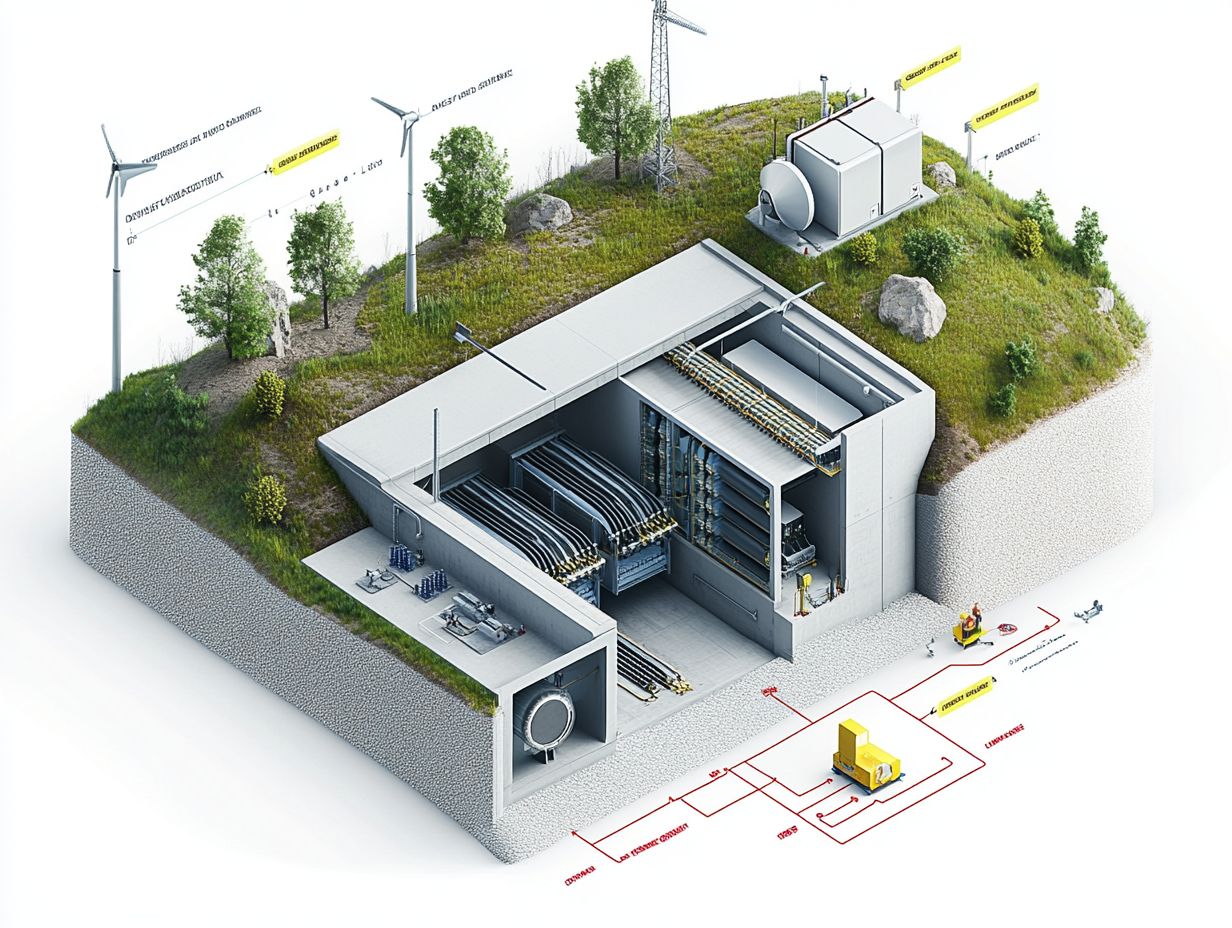
Reduced energy costs stand out as one of the most compelling advantages of energy storage systems. They allow you to take full advantage of energy arbitrage. By purchasing energy at lower rates during off-peak hours, you can significantly cut down on your overall electricity expenses. This change also contributes to a more sustainable energy future.
Essentially, these systems serve as a buffer for you. They enable you to store excess energy generated when rates are low and discharge it during peak hours when demand and prices rise. Understanding the science behind energy storage technologies can help you make informed decisions about your energy use.
Imagine saving over $100,000 by simply changing your energy habits! A notable case study of a commercial facility that adopted energy storage achieved annual savings exceeding this amount by adjusting their energy consumption patterns.
By lessening your reliance on grid electricity, these systems also bolster your resilience against price fluctuations. This makes them an appealing option for both residential and commercial energy users.
Engaging in energy arbitrage not only enhances your financial situation but also fosters a greener energy landscape for everyone.
Increased Reliability and Flexibility
Increased reliability and flexibility are essential benefits that energy storage systems bring to the table. They significantly enhance the performance of battery storage solutions within energy frameworks. By smoothing out the fluctuations in energy demand and supply, these systems provide critical grid services that bolster the overall stability and resilience of power networks.
Energy storage systems are key to using renewable energy. They allow you to achieve a more balanced and sustainable mix of power generation. By storing excess energy produced during peak generation times, they ensure that energy is readily available when demand surges. This also alleviates the pressure on traditional power plants.
This flexibility gives you the power to manage grid demand effectively. It enables a seamless transition between diverse energy sources.
Ultimately, implementing these solutions leads to a more responsive energy infrastructure. This paves the way for innovative energy strategies and enhanced reliability for consumers like you.
Considerations for Choosing an Energy Storage System
Once you’ve seen the benefits, it s time to choose the right system for your needs. When selecting an energy storage system, consider several key factors. Conducting a thorough cost-benefit analysis is essential, as is assessing the long-term sustainability of the technology.
As a project stakeholder, evaluate operational profiles, installation and maintenance costs, and the overall effectiveness of energy management systems in addressing your specific energy requirements. Each of these elements plays a crucial role in ensuring that your investment aligns with both current and future energy needs.
Cost vs. Benefits Analysis
Conducting a cost vs. benefits analysis is essential for you to evaluate the financial feasibility of energy storage systems. You’ll want to consider installation costs, maintenance costs, CAPEX, and O&M expenses. CAPEX (capital expenditure) refers to the initial costs of purchasing an energy storage system, while O&M (operations and maintenance) covers ongoing costs.
This analysis gives you the power to make informed decisions regarding which storage solutions will yield the best return on investment while meeting your operational needs. Don’t overlook key elements like energy efficiency, lifecycle benefits, and the potential for grid independence. For more details, check out how much home energy storage systems cost.
Your evaluation should incorporate metrics like payback period, net present value (NPV), and internal rate of return (IRR) to effectively quantify the financial impact of your investment.
By examining the system’s performance under varying conditions such as peak demand periods and renewable energy integration, you can better understand its reliability and capacity to minimize energy costs. A thorough approach will significantly aid you in identifying how to choose the right energy storage system that aligns best with both your financial objectives and technical requirements.
Long-Term Sustainability
Long-term sustainability is essential for energy storage systems. It encompasses critical factors like battery recycling, residual value, and the overall efficiency of these technologies. To ensure these systems perform exceptionally throughout their lifecycle, robust performance monitoring and a steadfast commitment to sustainable practices are necessary.
The significance of integrating sustainable solutions cannot be overstated. As the demand for renewable energy sources continues to rise, prioritizing battery recycling minimizes environmental impact. It also helps recover valuable materials, enhancing the residual value of spent batteries. This approach not only conserves vital resources but also fosters a circular economy, where products are reused and repurposed.
Implementing effective sustainability practices cuts costs and builds public trust. This attracts investment in cleaner technologies, driving global sustainability efforts.
Frequently Asked Questions
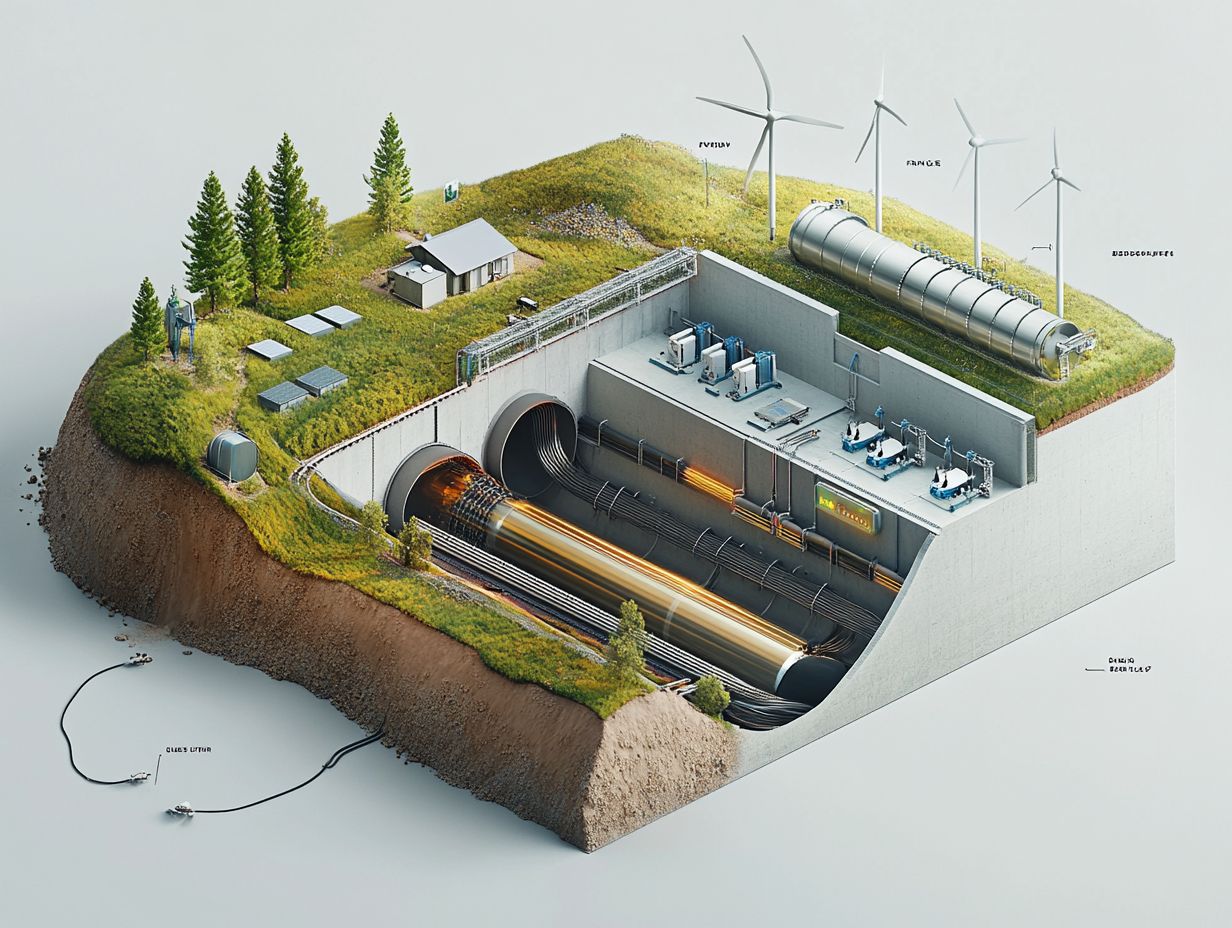
What is energy storage and why is it important to understand its costs?
Energy storage is the process of capturing and storing energy for later use. Understanding its costs is crucial because it can significantly impact the overall cost of energy production and consumption. This knowledge helps us make informed decisions about implementing energy storage solutions, ensuring the most cost-effective use of energy.
What Costs Should You Expect for Energy Storage?
The main components of the costs involved in energy storage include initial investment costs, operation and maintenance costs, and replacement or upgrade costs. These can vary depending on the type of energy storage technology used, the size and capacity of the system, and other factors.
How Do Costs Vary Among Different Energy Storage Technologies?
The costs of different energy storage technologies vary significantly. For example, pumped hydro storage is generally considered the cheapest form of energy storage, while lithium-ion batteries are more expensive. However, costs depend on the specific project and location, making it essential to evaluate all options carefully.
What Key Factors Influence the Costs of Energy Storage?
Key factors that influence the costs of energy storage include the type of technology used, the size and capacity of the system, and the cost of materials and labor. Additionally, factors such as location, regulatory requirements, and market conditions also impact storage costs.
How Can Understanding Energy Storage Costs Aid Project Planning?
Understanding the costs involved in energy storage is crucial for project planning and investment decisions. Accurately assessing costs allows project developers and investors to determine the feasibility and profitability of energy storage projects. It also helps identify cost-reducing measures and find the most cost-effective energy storage solution for a specific project or location.
Are There Potential Cost Savings with Energy Storage?
Yes, there are potential cost savings associated with energy storage. Implementing energy storage systems, including lithium-ion battery technologies, can reduce the need for expensive infrastructure upgrades, improve the efficiency and reliability of the energy grid, and lower the overall cost of energy production and consumption, including fixed and variable costs. Additionally, as technology advances and economies of scale are achieved, particularly with solar PV and solar panels, the costs of energy storage are expected to decrease, making it a more affordable option in the future. The Levelized Cost of Storage (LCOS), a measure of the average cost of storing energy over the lifetime of the storage system, will also play a crucial role in determining the economic viability of these systems, especially concerning electric vehicles and battery cycling.
Explore how energy storage can revolutionize your energy strategy today!


